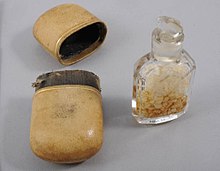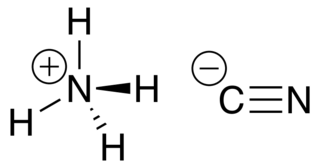
Smelling salts, also known as ammonia inhalants, spirit of hartshorn or sal volatile, are chemical compounds used as stimulants to restore consciousness after fainting. [1]

Smelling salts, also known as ammonia inhalants, spirit of hartshorn or sal volatile, are chemical compounds used as stimulants to restore consciousness after fainting. [1]
The usual active compound is ammonium carbonate—a colorless-to-white, crystalline solid ((NH4)2CO3). [1] Because most modern solutions are mixed with water, they should properly be called "aromatic spirits of ammonia". [1] Modern solutions may also contain other products to perfume or act in conjunction with the ammonia, such as lavender oil or eucalyptus oil. [2]
Historically, smelling salts have been used on people feeling faint, [3] [4] [5] or who have fainted. They are usually administered by others but may be self-administered.
Smelling salts are often used on athletes (particularly boxers) who have been dazed or knocked unconscious to restore consciousness and mental alertness. Smelling salts are now banned in most boxing competitions. [1]
They are also used as a form of stimulant in athletic competitions (such as powerlifting, strong man, rugby and ice hockey) to "wake up" competitors to perform better. [1] [6] In 2005, Michael Strahan estimated that 70–80% of National Football League players were using smelling salts as stimulants. [7]

Smelling salts have been used since Roman times and are mentioned in the writings of Pliny as Hammoniacus sal. [1] Evidence exists of use in the 13th century by alchemists as sal ammoniac. [1] In the 14th-century "The Canon's Yeoman's Tale" one of Chaucer's The Canterbury Tales , an alchemist purports to use sal armonyak. [8] In the 17th century, the distillation of an ammonia solution from shavings of harts' (deer) horns and hooves led to the alternative name for smelling salts as spirit or salt of hartshorn. [1]
They were widely used in Victorian Britain to revive fainting women, and in some areas, constables would carry a container of them for the purpose. [9] During this time, smelling salts were commonly dissolved with perfume in vinegar or alcohol and soaked onto a sponge, which was then carried on the person in a decorative container called a vinaigrette. [10] [11] The sal volatile appears several times in Dickens' novel Nicholas Nickleby .
The use of smelling salts was widely recommended during the Second World War, with all workplaces advised by the British Red Cross and St. John Ambulance to keep smelling salts in their first aid boxes. [12]

Solid ammonium carbonate and ammonium bicarbonate salts partly dissociate to form NH
3 , CO
2 and H
2O vapour as follows:
The smelling salts release ammonia (NH
3) gas, which triggers an inhalation reflex. It causes the muscles that control breathing to work faster by irritating the mucous membranes of the nose and lungs. [6]
Fainting can be caused by excessive parasympathetic and vagal activity that slows the heart and decreases perfusion of the brain. [13] The sympathetic irritant effect is exploited to counteract these vagal parasympathetic effects and thereby reverse the faint. [14]
Ammonia gas is toxic in large concentrations for prolonged periods and can be fatal. [1] [5] If a high concentration of ammonia is inhaled too close to the nostril, it might burn the nasal or oral mucosa. The suggested distance is 10–15 centimetres (4–6 in). [1]
The use of ammonia smelling salts to revive people injured during sport is not recommended because it may inhibit or delay a proper and thorough neurological assessment by a healthcare professional, [1] such as after concussions when hospitalization may be advisable, and some governing bodies recommend specifically against it. [15] The irritant nature of smelling salts means that they can exacerbate any pre-existing cervical spine injury by causing reflex withdrawal away from them, although this has been found to be a result of holding the smelling salts closer to the nose than recommended. [1]

Ammonia is an inorganic chemical compound of nitrogen and hydrogen with the formula NH3. A stable binary hydride and the simplest pnictogen hydride, ammonia is a colourless gas with a distinctive pungent smell. Biologically, it is a common nitrogenous waste, and it contributes significantly to the nutritional needs of terrestrial organisms by serving as a precursor to fertilisers. Around 70% of ammonia produced industrially is used to make fertilisers in various forms and composition, such as urea and diammonium phosphate. Ammonia in pure form is also applied directly into the soil.

The ammonium cation is a positively charged polyatomic ion with the chemical formula NH+4 or [NH4]+. It is formed by the protonation of ammonia. Ammonium is also a general name for positively charged (protonated) substituted amines and quaternary ammonium cations, where one or more hydrogen atoms are replaced by organic or other groups.

In chemistry, there are three definitions in common use of the word "base": Arrhenius bases, Brønsted bases, and Lewis bases. All definitions agree that bases are substances that react with acids, as originally proposed by G.-F. Rouelle in the mid-18th century.

Sodium carbonate is the inorganic compound with the formula Na2CO3 and its various hydrates. All forms are white, odourless, water-soluble salts that yield alkaline solutions in water. Historically, it was extracted from the ashes of plants grown in sodium-rich soils, and because the ashes of these sodium-rich plants were noticeably different from ashes of wood, sodium carbonate became known as "soda ash". It is produced in large quantities from sodium chloride and limestone by the Solvay process, as well as by carbonating sodium hydroxide which is made using the Chlor-alkali process.
Carbonation is the chemical reaction of carbon dioxide to give carbonates, bicarbonates, and carbonic acid. In chemistry, the term is sometimes used in place of carboxylation, which refers to the formation of carboxylic acids.

Ammonium chloride is an inorganic chemical compound with the chemical formula NH4Cl, also written as [NH4]Cl. It is an ammonium salt of hydrogen chloride. It consists of ammonium cations [NH4]+ and chloride anions Cl−. It is a white crystalline salt that is highly soluble in water. Solutions of ammonium chloride are mildly acidic. In its naturally occurring mineralogic form, it is known as sal ammoniac. The mineral is commonly formed on burning coal dumps from condensation of coal-derived gases. It is also found around some types of volcanic vents. It is mainly used as fertilizer and a flavouring agent in some types of liquorice. It is a product of the reaction of hydrochloric acid and ammonia.

Ammonium bicarbonate is an inorganic compound with formula (NH4)HCO3. The compound has many names, reflecting its long history. Chemically speaking, it is the bicarbonate salt of the ammonium ion. It is a colourless solid that degrades readily to carbon dioxide, water and ammonia.
Ammonia solution, also known as ammonia water, ammonium hydroxide, ammoniacal liquor, ammonia liquor, aqua ammonia, aqueous ammonia, or (inaccurately) ammonia, is a solution of ammonia in water. It can be denoted by the symbols NH3(aq). Although the name ammonium hydroxide suggests an alkali with the composition [NH+
4][OH−
], it is actually impossible to isolate samples of NH4OH. The ions NH+
4 and OH− do not account for a significant fraction of the total amount of ammonia except in extremely dilute solutions.
The Solvay process or ammonia–soda process is the major industrial process for the production of sodium carbonate (soda ash, Na2CO3). The ammonia–soda process was developed into its modern form by the Belgian chemist Ernest Solvay during the 1860s. The ingredients for this are readily available and inexpensive: salt brine (from inland sources or from the sea) and limestone (from quarries). The worldwide production of soda ash in 2005 was estimated at 42 million tonnes, which is more than six kilograms (13 lb) per year for each person on Earth. Solvay-based chemical plants now produce roughly three-quarters of this supply, with the remaining being mined from natural deposits. This method superseded the Leblanc process.

Hartshorn is the antler of male red deer.
The nitrophosphate process is a method for the industrial production of nitrogen fertilizers invented by Erling Johnson in the municipality of Odda, Norway around 1927.

Ammonium carbonate is a salt with the chemical formula (NH4)2CO3. Since it readily degrades to gaseous ammonia and carbon dioxide upon heating, it is used as a leavening agent and also as smelling salt. It is also known as baker's ammonia and is a predecessor to the more modern leavening agents baking soda and baking powder. It is a component of what was formerly known as sal volatile and salt of hartshorn, and produces a pungent smell when baked. It comes in the form of a white powder or block, with a molar mass of 96.09 g/mol and a density of 1.50 g/cm3. It is a strong electrolyte.
Classical qualitative inorganic analysis is a method of analytical chemistry which seeks to find the elemental composition of inorganic compounds. It is mainly focused on detecting ions in an aqueous solution, therefore materials in other forms may need to be brought to this state before using standard methods. The solution is then treated with various reagents to test for reactions characteristic of certain ions, which may cause color change, precipitation and other visible changes.

Ammonium sulfate (American English and international scientific usage; ammonium sulphate in British English); (NH4)2SO4, is an inorganic salt with a number of commercial uses. The most common use is as a soil fertilizer. It contains 21% nitrogen and 24% sulfur.
Selective catalytic reduction (SCR) means of converting nitrogen oxides, also referred to as NO
x with the aid of a catalyst into diatomic nitrogen, and water. A reductant, typically anhydrous ammonia, aqueous ammonia, or a urea solution, is added to a stream of flue or exhaust gas and is reacted onto a catalyst. As the reaction drives toward completion, nitrogen, and carbon dioxide, in the case of urea use, are produced.
The Kjeldahl method or Kjeldahl digestion (Danish pronunciation:[ˈkʰelˌtɛˀl]) in analytical chemistry is a method for the quantitative determination of a sample's organic nitrogen plus ammonia/ammonium. (NH3/NH4+). Without modification, other forms of inorganic nitrogen, for instance nitrate, are not included in this measurement. Using an empirical relation between Kjeldahl nitrogen and protein, it is an important method for indirectly quantifying protein content of a sample. This method was developed by Johan Kjeldahl in 1883.
Carbamic acid, which might also be called aminoformic acid or aminocarboxylic acid, is the chemical compound with the formula H2NCOOH. It can be obtained by the reaction of ammonia NH3 and carbon dioxide CO2 at very low temperatures, which also yields ammonium carbamate [NH4]+[NH2CO2]−. The compound is stable only up to about 250 K (−23 °C); at higher temperatures it decomposes into those two gases. The solid apparently consists of dimers, with the two molecules connected by hydrogen bonds between the two carboxyl groups –COOH.

Barium chlorate, Ba(ClO3)2, is the barium salt of chloric acid. It is a white crystalline solid, and like all soluble barium compounds, irritant and toxic. It is sometimes used in pyrotechnics to produce a green color. It also finds use in the production of chloric acid.

Ammonium cyanide is an unstable inorganic compound with the formula NH4CN.

Ammonium carbamate is a chemical compound with the formula [NH4][H2NCO2] consisting of ammonium cation NH+4 and carbamate anion NH2COO−. It is a white solid that is extremely soluble in water, less so in alcohol. Ammonium carbamate can be formed by the reaction of ammonia NH3 with carbon dioxide CO2, and will slowly decompose to those gases at ordinary temperatures and pressures. It is an intermediate in the industrial synthesis of urea (NH2)2CO, an important fertilizer.